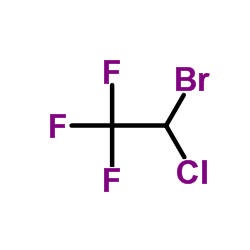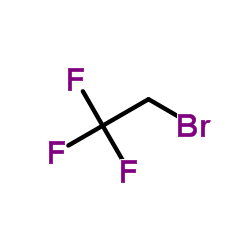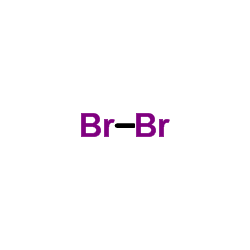Halothane

Halothane structure
|
Common Name | Halothane | ||
|---|---|---|---|---|
| CAS Number | 151-67-7 | Molecular Weight | 197.382 | |
| Density | 1.9±0.1 g/cm3 | Boiling Point | 53.4±8.0 °C at 760 mmHg | |
| Molecular Formula | C2HBrClF3 | Melting Point | N/A | |
| MSDS | Chinese USA | Flash Point | -13.9±18.4 °C | |
| Symbol |



GHS05, GHS07, GHS08 |
Signal Word | Danger | |
| Name | halothane |
|---|---|
| Synonym | More Synonyms |
| Density | 1.9±0.1 g/cm3 |
|---|---|
| Boiling Point | 53.4±8.0 °C at 760 mmHg |
| Molecular Formula | C2HBrClF3 |
| Molecular Weight | 197.382 |
| Flash Point | -13.9±18.4 °C |
| Exact Mass | 195.890213 |
| LogP | 2.30 |
| Vapour Pressure | 268.8±0.1 mmHg at 25°C |
| Index of Refraction | 1.389 |
| Storage condition | 2-8°C |
CHEMICAL IDENTIFICATION
HEALTH HAZARD DATAACUTE TOXICITY DATA
MUTATION DATA
|
| Symbol |



GHS05, GHS07, GHS08 |
|---|---|
| Signal Word | Danger |
| Hazard Statements | H315-H318-H335-H360 |
| Precautionary Statements | P201-P261-P280-P305 + P351 + P338-P308 + P313 |
| Personal Protective Equipment | Eyeshields;full-face respirator (US);Gloves;multi-purpose combination respirator cartridge (US) |
| Hazard Codes | T,Xi,Xn |
| Risk Phrases | R36 |
| Safety Phrases | S53-S23-S26-S36/37-S45-S36 |
| RIDADR | UN 3334 |
| WGK Germany | 3 |
| RTECS | KH6550000 |
| HS Code | 2903799090 |
|
~83% 
Halothane CAS#:151-67-7 |
| Literature: Hu, Chang-Ming; Tu, Ming-Hu Journal of Fluorine Chemistry, 1991 , vol. 55, # 1 p. 101 - 104 |
|
~% 
Halothane CAS#:151-67-7 |
| Literature: Journal of Organic Chemistry, , vol. 48, # 2 p. 242 - 250 |
|
~% 
Halothane CAS#:151-67-7 |
| Literature: US2849502 , ; DE1018853 , ; |
|
~% 
Halothane CAS#:151-67-7 |
| Literature: US2849502 , ; DE1018853 , ; |
|
~% 
Halothane CAS#:151-67-7 |
| Literature: Journal of Organic Chemistry, , vol. 48, # 2 p. 242 - 250 |
|
~% 
Halothane CAS#:151-67-7 |
| Literature: Journal of the Chemical Society, , p. 387,395 |
|
~% 
Halothane CAS#:151-67-7
Detail
|
| Literature: Journal of the Chemical Society, , p. 387,395 |
| HS Code | 2903799090 |
|---|---|
| Summary | 2903799090 halogenated derivatives of acyclic hydrocarbons containing two or more different halogens。Supervision conditions:None。VAT:17.0%。Tax rebate rate:9.0%。MFN tariff:5.5%。General tariff:30.0% |
|
Neurobehavioral Differences Between Mice Receiving Distinct Neuregulin Variants as Neonates; Impact on Sensitivity to MK-801.
Curr. Mol. Med. 15 , 222-36, (2015) Neuregulin-1 (NRG1) is a well-recognized risk gene for schizophrenia and is often implicated in the neurodevelopmental hypothesis of this illness. Alternative splicing and proteolytic processing of th... |
|
|
MeCP2 Affects Skeletal Muscle Growth and Morphology through Non Cell-Autonomous Mechanisms.
PLoS ONE 10 , e0130183, (2015) Rett syndrome (RTT) is an autism spectrum disorder mainly caused by mutations in the X-linked MECP2 gene and affecting roughly 1 out of 10.000 born girls. Symptoms range in severity and include stereo... |
|
|
Cheminformatics analysis of assertions mined from literature that describe drug-induced liver injury in different species.
Chem. Res. Toxicol. 23 , 171-83, (2010) Drug-induced liver injury is one of the main causes of drug attrition. The ability to predict the liver effects of drug candidates from their chemical structures is critical to help guide experimental... |
| Halotan |
| Phthorothanum |
| Ftorotan |
| 1,1,1-trifluoro-2-chloro-2-bromoethane |
| Fluothane |
| Bromochlorotrifluoroethane |
| MFCD00009602 |
| Narcotan |
| EINECS 205-796-5 |
| R 123B1 |
| 1-bromo-1-chloro-2,2,2-trifluoroethane |
| BrCH(Cl)CF3 |
| 2-bromo-2-chloro-1,1,1-trifluoroethane |
| Ethane, 2-bromo-2-chloro-1,1,1-trifluoro- |
| Narcotane |
| 2-Chloro-2-bromo-1,1,1-trifluoroethane |
| (±)-Halothane |
| 1,1,1-trifluoro-chlorobromoethane |
| Rhodialothan |










